Hand Rearing African Grey Chicks

This blog will detail hand rearing of two African grey chicks. You may read about their parents and the clutch here . The two chicks hatched on Jan 6 and Jan 9, 2012. They were pulled on Jan 22 with one aged 13 days and the other 16 days. The chicks were close banded on Jan 22. The band id of the chicks are SAUD-202 and SAUD-203 respectively. Here is their first photo and their data. SAUD-202 (L) SAUD-203 (R) 13 and 19 days Old ID: SAUD-202 Hatch Date: Jan 6, 2012 Pulled on: Jan 22, 2012 (16 days) Weight: 129g ID: SAUD-203 Hatch Date: Jan 9, 2012 Pulled on: Jan 22, 2012 (13 days) Weight: 117g The chicks are housed inside a homemade brooder made out of an old fish tank. The bottom is covered with wood shavings and lined on top with tissue paper. The brooder temperature is maintained at 90'F. The chicks hatched 3 days apart but their size does not differ significantly. The older chick had its eyes open at the time of pulling w...









